Stuart Forster looks at the long history of the Scottish capital’s fortress and reasons to visit Edinburgh Castle.
Disclosure: Some of the links below are affiliate links, meaning, at no additional cost to you, I will earn a commission if you click through and make a purchase.
Edinburgh Castle dominates the Scottish capital’s skyline and is one of Scotland’s top tourist attractions. The fortress sits upon the formidable-looking Castle Rock and makes a fascinating place to spend a few hours.
The location of the fortification was selected for its strategic advantage. Inevitably, Castle Rock offers an impressive vantage point for views over Edinburgh and the surrounding landscape. I can look across the Firth of Forth and beyond. At the Argyle Battery, I lean on an 18-pounder gun, dating from the 1820s, and look down to Princes Street Gardens.
Trams trundling along Princes Street. The stone facades of Edinburgh’s New Town look grey through the mist of the morning. The term ‘new’ is relative to other parts of Edinburgh — the New Town was built from the 1760s into the mid-19th century.
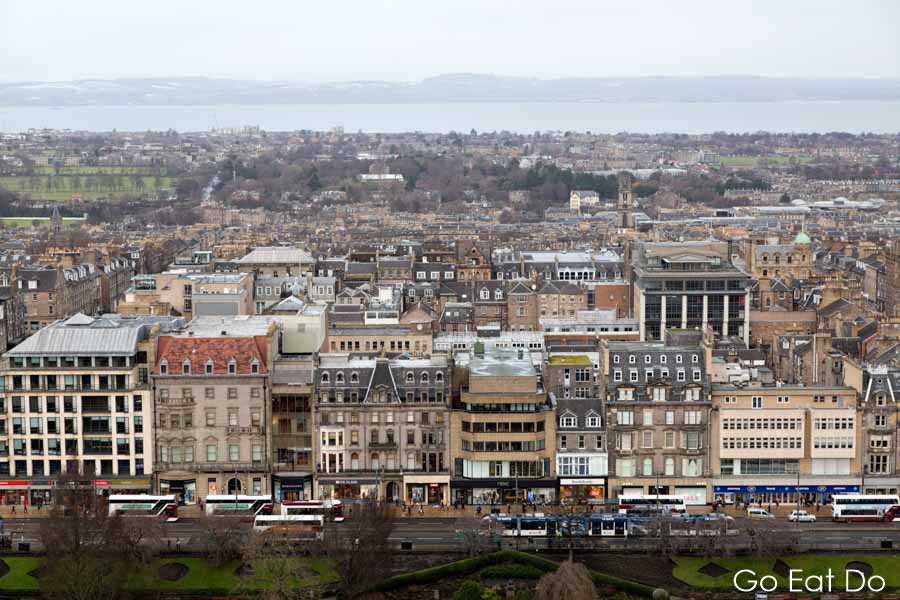
Reasons to visit Edinburgh Castle
Screeching seagulls wheeling in the sky cause me to turn towards Arthur’s Seat, the extinct volcano whose footpaths also offer impressive views over the city.
It’s not since I was a child — on a day trip out with my family — that I last entered the castle, so I’m looking forward to seeing what it has to offer visitors. Edinburgh Castle counts as one of Scotland’s top family attractions but, inevitably, has much for heritage lovers and travellers who appreciate military history.
The castle is still garrisoned. That means that not all the buildings on top of Castle Rock are accessible to the public. Most, however, are: providing insights into this long-used location. King David I of Scotland held his first assembly of nobles and clergy here in the 12th century. This is a place where Scottish and British history intertwines. In part, the castle tells of the rivalry between the Scots and English, yet it also conveys the significance of Scotland’s contribution to expanding the British Empire and in fighting more recent wars.
Looking at the sheer rocks and steep walls that protect Edinburgh Castle from assault, it’s hard to imagine any army scaling Castle Rock and overrunning the fortress. Yet in 1314 that happened. Soldiers of the Scottish Army scaled the rocks and took back the castle from the English.

Insights into Scottish history
Is it my imagination or is this a place where you really can feel a sense of history? I pause next to a guide and listen while he explains how the castle endured a 13-day bombardment by government forces in 1573, an event known as ‘the Lang Siege’. The garrison had rebelled in support of the deposed Mary Queen of Scots. The guide’s delivery is relaxed and assured: the group of international visitors he is leading look gripped by the stories he is telling. Booking an Edinburgh Castle tour is clearly an insightful way of learning about the fortress — tours last between one and three hours.
During the Jacobite Risings of the 1700s, the castle came under attack. After the first rising, in 1715, it became clear that the defences needed to be improved. That enabled the garrison to repel Bonny Prince Charlie’s forces in 1745. The castle stood loyal to the government while the Jacobite Army advanced southwards into England.
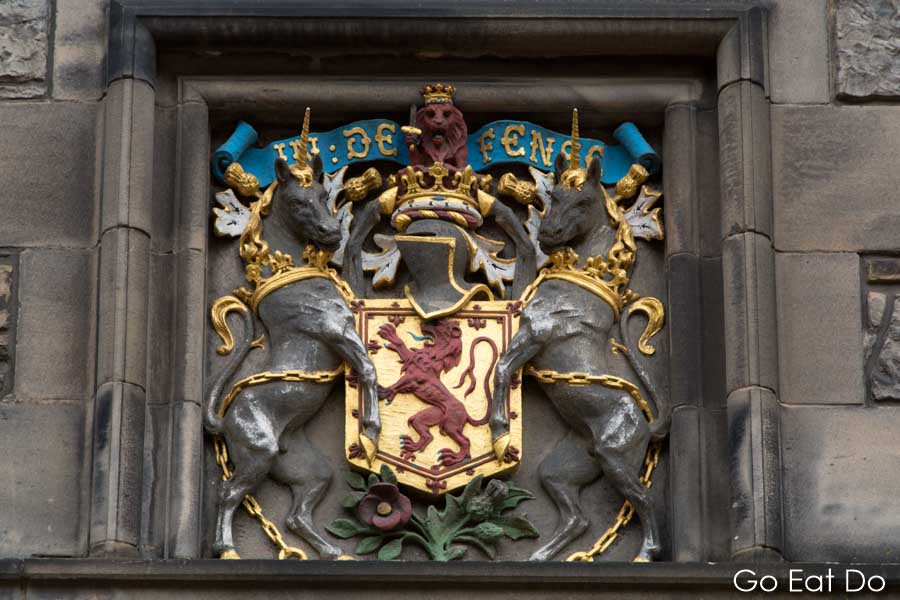
Edinburgh Castle’s military museums
For anyone interested in military history there’s certainly plenty to see up here in the castle. I pause for a moment and watch as visitors snap selfies by Mons Meg, once among the world’s biggest and most destructive cannons. The gun became part of King James II of Scotland’s arsenal in 1457 and could spit six-tonne stone balls up to two miles. In an age when warfare was characterised by archery, cavalry charges and massed infantry the gun must have made a major impression each time it fired. Did I stand by the gun as a six-year-old and have my photo taken on a sunny school holiday while visiting Edinburgh Castle with my family? I remember this place, albeit vaguely.
After viewing exhibits in the castle’s regimental museums I take a look around Scotland’s National War Museum. With recruitment posters, uniforms, weapons, medals and portraits of soldiers, the collection is expansive. It tells of Scottish soldiers’ involvement in conflicts around the globe, including fighting the army of Tipu Sultan at Seringapatnam, in southern India, and the trenches of the Western Front, during World War One.
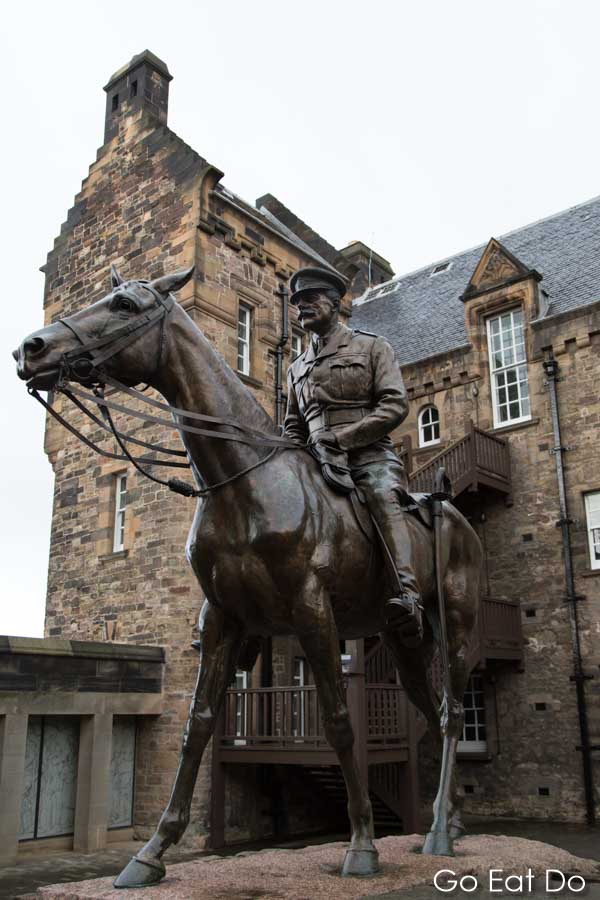
Edinburgh Castle’s prison cells
Being tricky to breach, Edinburgh Castle was a formidable place to attempt an escape. At the Prisons of War exhibit, within Dury’s Battery, I learn how pirates, privateers and prisoners of war were held within its walls. Hammocks strung between wooden frames represent the dank conditions French prisoners lived a little over two centuries ago. Even accounting for their daily ration of two pints of beer, it must have been a miserable place to be locked up. One sailor from the North American colonies preferred that then being executed as a pirate for serving on a rebel American ship and bluffed his way in by speaking French. By 1781 the castle held more than 1,000 prisoners, prompting an exchange of 500.
Across the courtyard, there’s a prison block that once held military prisoners in spartan, solitary confinement cells. The soldiers remanded could be deprived of bedding to enforce discipline. The punishment of carrying round shot with outstretched arms ensured that they would regret being caught drunk or asleep while on duty.
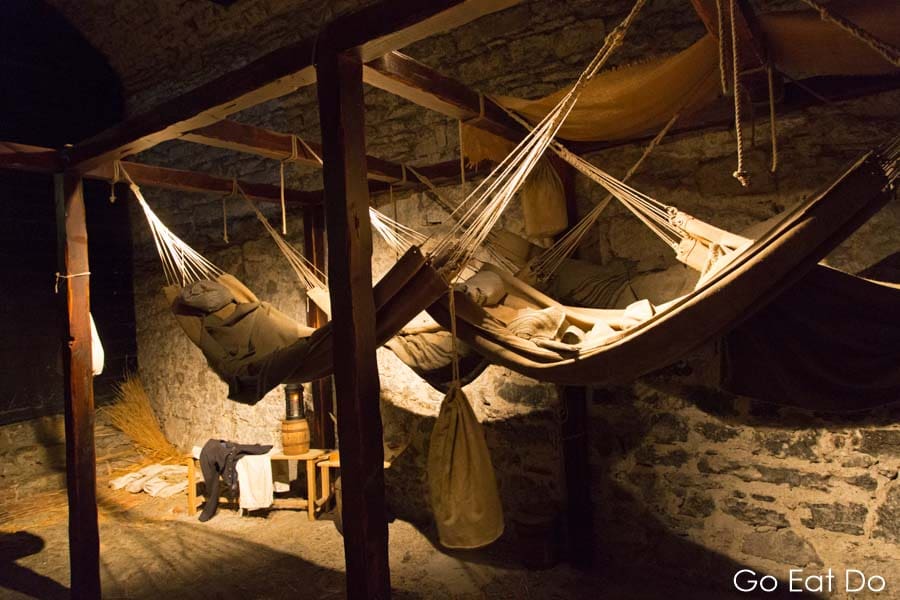
Scotland’s National War Memorial
The mood within the Scottish National War Memorial is sombre. It’s a place of reflection, commemorating the service and sacrifice of Scots and Scottish Regiments on battlefields in Europe and beyond since 1914. It was dedicated in 1927, less than a decade after the end of the war which claimed the lives of more than 147,000 Scottish troops.
Across Crown Square, the wood-panelled Great Hall displays historic arms and armour. Breastplates, basket-handled Claymore swords and pikes count among the artefacts on show. The hall was completed in 1512 and was used to host state banquets.
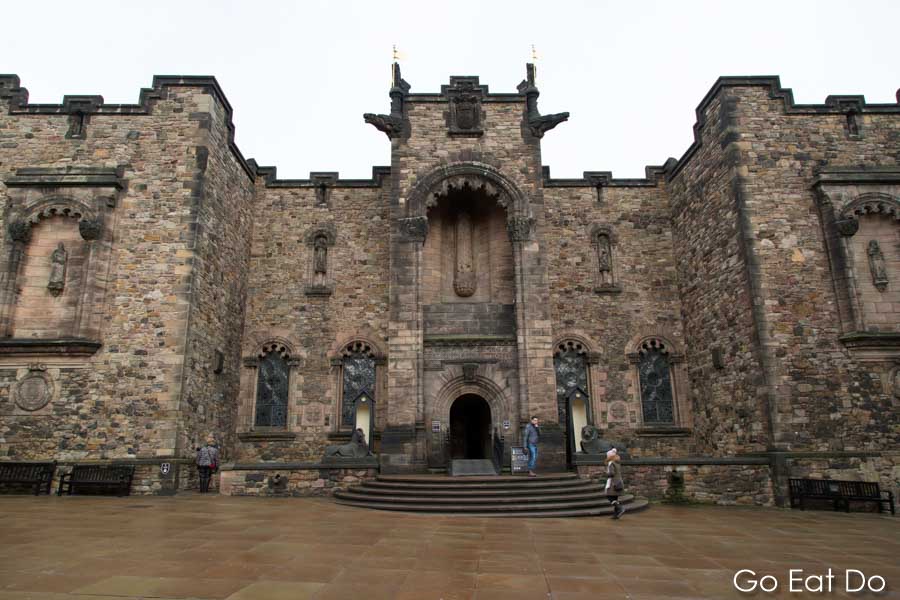
The Honours of Scotland
After a brief look around I head next door to view the Honours of Scotland, the country’s crown jewels. First used together for the coronation of Mary Queen of Scots in 1543, the shining sceptre, crown and other symbol-laden artefacts are displayed behind heavy-looking security glass. King Charles II was the last monarch to be crowned using the Honours of Scotland.
After the Act of Union united the English and Scottish crowns, in 1707, the jewels were sealed away. It was not until 1818 that the chest in which they had been stored was reopened. That act was led by Walter Scott, the author who penned the Waverley novels and who is remembered by the vast monument in Princes Street Gardens.
Edinburgh’s oldest building, St Margaret’s Chapel, stands within the castle grounds. It dates from the early 12th century. The altar stands beyond a carved stone arch in the austere, compact building that, over the centuries, has served as a gunpowder store.
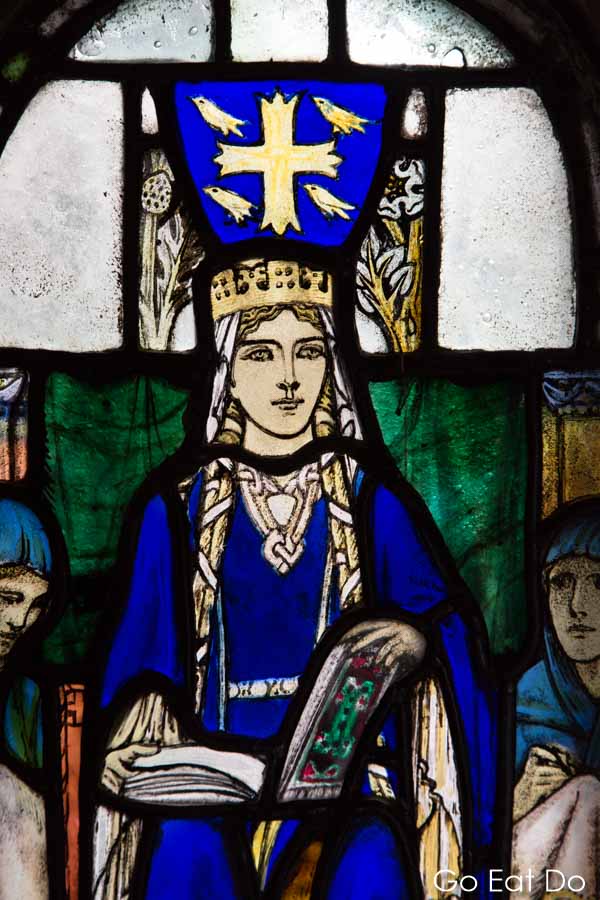
As I make my way back towards the entrance I pause for a moment to look over a wall and spot a tiny cemetery with headstones recording the names of the dogs who were the pets of soldiers who served at the castle.
Before leaving I check my watch. It’s almost one o’clock. A crown is starting to gather by the Mills Mount Battery. I watch as a soldier readies a modern field gun, checks the time and, eventually, fires. As the smoke dissipates I make my way towards the gatehouse and Edinburgh’s Royal Mile.
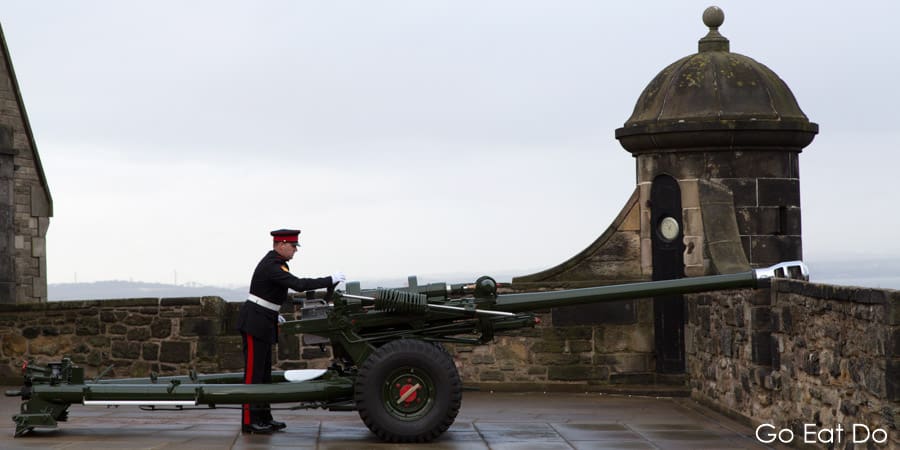
Hotels near Edinburgh Castle
Search for accommodation near Edinburgh Castle via Booking.com:
Booking.com
I enjoyed staying at the Hotel Indigo Edinburgh (51-59 York Place; tel. 0131 556 5577). It’s a 60-room, four-star property in interlinked Georgian townhouses. The hotel is located in Edinburgh’s New Town, a couple of minutes’ walk from The Stand Comedy Club and Scottish National Portrait Gallery. The minibar is stocked with a selection of non-alcoholic drinks and snacks, and breakfast includes the choice of a fry-up, eggs Benedict and vegan options.
Travel to Edinburgh
Edinburgh Airport is approximately 8.5 miles from the city centre. The Airlink 100 bus runs from the airport to stops in the city centre, taking approximately 30 minutes. Edinburgh Trams also cover the route.
Trains running on Britain’s East Coast Main Line stop at Edinburgh Waverley railway station.
Restaurants near Edinburgh Castle
If you enjoy fine dining experiences, reserve a table at The Witchery by the Castle (325 Castlehill; tel: 0131 225 5613). The restaurant has oak-panelled walls, red leather banquettes and is within an easy stroll of Edinburgh Castle. The cuisine served showcases Scottish produce and the table d’hôte menu represents good value.
When to visit Edinburgh
Edinburgh Castle is open throughout the year. The Royal Edinburgh Military Tattoo is held annually in August.
Don’t miss…
While you’re in Edinburgh don’t miss the opportunity to see the One o’clock Gun being fired (daily, except Sundays, Good Friday and Christmas Day). The tradition dates back to 1861 when it provided the city’s residents with a reliable means of setting their timepieces.
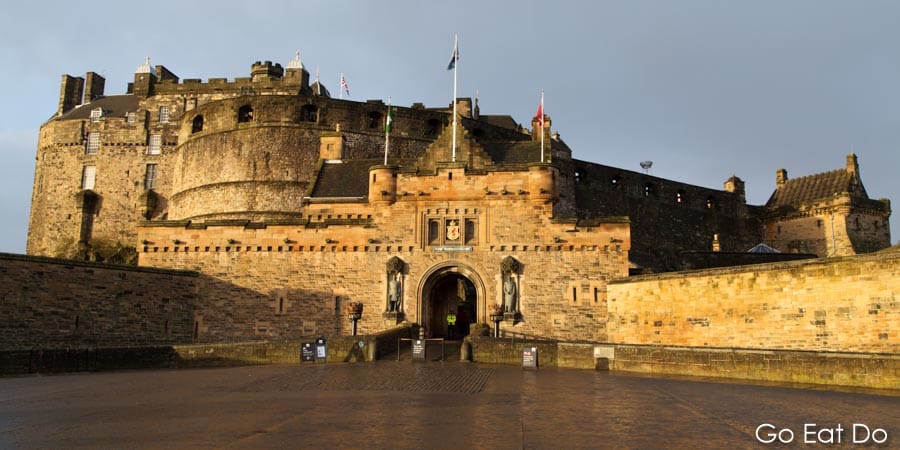
Map of Edinburgh Castle
The map below shows the location of Edinburgh Castle in the heart of the Scottish capital:
Books about Edinburgh
If you are planning on visiting Edinburgh you may want to read up about the city in advance of travelling. If you’re going to visit Edinburgh Castle you may enjoy reading the official guidebook:

Martin Fry is the author of Edinburgh: A History of the City:

For suggestions on walking tours of the city, take a look at Edinburgh’s Hidden Walks by Stephen Millar and Vicky Wilson:

Travelling to Edinburgh with youngsters or looking for a gift? Edinburgh Castle for Kids: Fun Facts and Amazing Activities is by Moreno Chiacchiera:

Only in Edinburgh: A Guide to Unique Locations, Hidden Corners and Unusual Objects compelling guide to quirky aspects of the city, written by Duncan J.D. Smith:

Tickets for Edinburgh Castle
Find Edinburgh Castle opening times and ticket prices on the landmark’s website.
Purchasing a ticket online allows you to enter the castle within a specified time window. Guided tours of Edinburgh Castle are included in the ticket price and depart from the Portcullis Gate. Audio tours are available for hire. To ensure entry, it’s worthwhile going online to book tickets in advance if you plan on visiting Edinburgh at a busy time of year.
Learn more about the city and its attractions on the This is Edinburgh and Visit Scotland tourism information websites.
If you enjoy visiting attractions that have a long history, take a look at the Historic Environment Scotland website for ideas about places to visit.
Stuart Forster, the author of this post, is an award-winning travel writer. Stuart studied history and has visited Edinburgh many times.
Photos illustrating this post are by Why Eye Photography. Why Eye Photography is available for travel photography commissions and to host photography training courses in the UK and beyond.
If you enjoyed this post why not sign up for the free Go Eat Do newsletter? It’s a hassle-free way of getting links to posts on a monthly basis.
‘Like’ the Go Eat Do Facebook page to see more photos and content.
A version of this post was initially published on Go Eat Do on 4 March 2018.





Cath Royale
March 6, 2018 at 03:01This is a wonderful piece of writing. It’s left me keen to explore the castle.
Stuart Forster
March 7, 2018 at 09:46Hopefully you get a chance to do that soon.
Bea Adventurous
January 11, 2022 at 19:45This is such an incredible blog! I’ve been before and this has just made me re-live those amazing memories as if I was there again.
I also love how you’ve included places to dine, where to stay and how to get there. I’m sure this will be extremely beneficial to a lot more people!
Thank you for this.
Go Eat Do
January 14, 2022 at 13:29Thanks Bea, it’s an incredible city that I look forward to visiting again soon.
Elena Gilbert
January 12, 2022 at 10:54Amazing and very interesting blog, loved reading it please keep on writing blogs like this.
Go Eat Do
January 14, 2022 at 13:31Thank you, Elena.